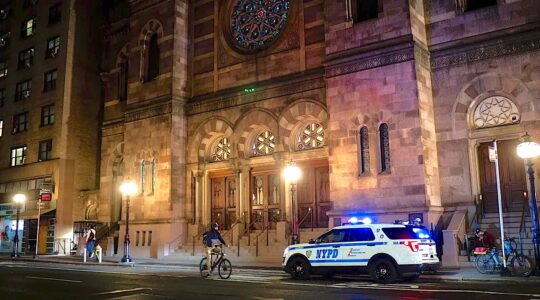Rabbi Jeffrey Salkin, a voice for spirituality in non-Orthodox circles, devoted his earlier books to bringing God back into the lives of Jews, at synagogue and at work.
Rabbi Salkin devotes his latest book to bringing Jews — the half of the Jewish people who have largely seemed lost from their tradition — back into Jewish life. Especially male Jews.
Rabbi Salkin, executive director of Kol Echad, a “transdenominational” adult educational project in Atlanta, previously served as a pulpit rabbi, where he observed a trend: Jewish men, outside of the Orthodox community, were fleeing from religious Jewish life.
That both alarmed him and inspired him to create “The Modern Men’s Torah Commentary: New Insights from Jewish Men on the 54 Weekly
AHA
Torah Portions” (Jewish Lights, $24.99).
The new book, a contribution to the emerging men’s movement in Judaism, is a 331-page answer to a question Rabbi Salkin asks in the introduction: “How can we get Jewish men back into serious, engaging religious life?”
His succinct answer is the Torah, and new, male-centered interpretations of the parshiot read each Shabbat in shul. The 59 extended answers (multiple commentaries are offered for a few Torah portions) come from a wide variety of contributors, secular to Orthodox, straight and gay, rabbis and scholars. Among the contributors are a journalist, a musician and a talk-show host.
All the contributors, including Rabbi Salkin himself, who chose the first parashah in Exodus, are, needless to say, men.
Rabbi Salkin sent out a call for commentaries a few years ago. “First come, first served,” he says in a telephone interview — early signers-on had their pick of parashah. The rabbi’s only guideline: write about some unique meaning for Jewish men you see in the Torah’s words. “What do you see in the text?” Rabbi Salkin asked.
What he wanted was not so simple as a collection of Torah commentaries written by men. The men saw health issues and body image, aging and sexuality, materialism and aggression. Not standard fare for pilpul, or intricate analysis.
The language and approach to text in Rabbi Salkin’s book are as varied as the backgrounds of the writers. “In keeping with a commitment to Jewish pluralism and diversity, we have respected the predilections of various authors and maintained their preference for different designations of the Deity, including G-d, Hashem and the Divine Name,” he writes.
“Likewise, we have respected the wishes and/or grammatical predilections of our various authors who have chosen to refer to God in the third person with the pronoun ‘He,’ while we simultaneously recognize the awkwardness of using any pronoun to refer to a God who transcends gender.
“Many of them stretched their minds and souls in order to look deeply into the text, in ways that they had never done before,” the rabbi writes.
Support the New York Jewish Week
Our nonprofit newsroom depends on readers like you. Make a donation now to support independent Jewish journalism in New York.
Take the commentary by Rabbi Daniel Landis, director of the Pardes Institute of Jewish Studies in Jerusalem, on parshat Ki Tetzei, whose theme is men going to war. The Torah’s context is battles in biblical times. Rabbi Landis focuses on military responsibilities in modern Israel.
“Going out to war is an anticipated part of Israeli culture,” Rabbi Landis writes, telling of a telephone repairman who asks a friend itn a park the age of his son. Eight, replied the second man. Ten more years, replied the first. “It took me a moment to realize that they were referring to the fact he [the second man’s son] would eventually go into the army. That fact is always on Israeli minds.”
Rabbi Landis develops the rest of his commentary in a similar personal, anecdotal tone, as do many of the authors in Rabbi Salkin’s book.
An obvious question, which Rabbi Salkin has heard many times — before the advent of the feminist movement and the several women’s Torah commentaries that have appeared in the last decade — weren’t all Torah commentaries written by men? Why do we need another Torah commentary written by men? Male authorship doesn’t equate with male perspective, Rabbi Salkin answers.
“Sure, Rashi [the classical commentator on the Torah and Talmud] and every other sage was a man,” he says, “but they didn’t pay attention to the deep needs of contemporary Jewish men.”
Rashi, in other words, didn’t discuss burnout or self-sacrifice.
“The traditional commentators by and large did not deal with the issue of masculinity in the text,” Rabbi Salkin says. “They did not speak to the issues going on in men’s lives.” Enter the word “Modern” in the book’s title.
“Gender consciousness is relatively new within Western culture,” the rabbi says — such commentaries simply could not be written in previous generations.
The rabbi says his book follows in the footsteps of the women’s Torah commentaries that treated the text from a particularly female point of view.
Both men and women, he says, “view the world through a gender lens. What feminists did is remind us of the gendered nature of human existence. This work could not have existed without the feminist grandmothers.”
A more personal understanding of the Torah’s message, divided into its weekly readings, is a natural re-entry point into synagogue life, Rabbi Salkin says. “If you believe that God created us in the Divine Image, we need both genders in Jewish life.”
His goal: a “sense of balance” between male and female involvement with Jewish life. In recent years, statistical and anecdotal evidence suggest, women have come to dominate once male-heavy attendance at synagogue services, as well as volunteer service, while men have largely disappeared.
“In almost every venue of contemporary Jewish life,” he writes, “Jewish men demonstrate far less interest in Judaism than women do — from school age through adulthood.”
Support the New York Jewish Week
Our nonprofit newsroom depends on readers like you. Make a donation now to support independent Jewish journalism in New York.
“There’s a sense,” the rabbi says, “that synagogue life has become a feminized domain.”
One current example: a photograph in the summer 2009 issue of Reform Judaism magazine that illustrates an article about a congregation renting space in a funeral home in Edmonton, Canada, shows a group of congregants carrying a Torah scroll from its old home to its new one. Nearly all the participants are women.
Rabbi Salkin wants men in the picture.
“This is definitely not a clarion call for men to re-conquer Jewish life and to re-occupy synagogue roles that women have rightly entered,” Rabbi Salkin says. “This is its own form of affirmative action.”
“While we do not in any way mourn the passing of the exclusively male minyan, it is unfortunate that men are increasingly distancing themselves from Jewish religious life — as worshipers, as students of Torah, and as synagogue leaders,” Rabbi Salkin writes.
“It’s not as if synagogues want to exclude men; that is hardly the case. Women were able to articulate what they wanted — what they demanded – out of Jewish life. Men must do the same thing, and vigorously.”
“The question is whether the pendulum has swung too far, that men are disappearing from the synagogue,” says Steven Bayme, director of the American Jewish Committee’s Department of Contemporary Jewish Life.
“The successful synagogues today are the ones moving to programs that involve the entire family.”
Rabbi Salkin says his book of commentaries fills a spiritual vacuum. “If this book did not exist,” he says, “Jewish men might still be scratching their heads and asking, ‘What’s in Judaism for me?’ We believe,” he says, “that just as women came back into Jewish life, the same thing can happen to men.”
The New York Jewish Week brings you the stories behind the headlines, keeping you connected to Jewish life in New York. Help sustain the reporting you trust by donating today.




